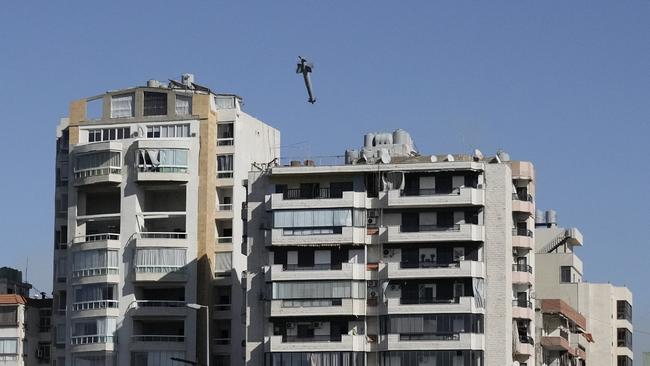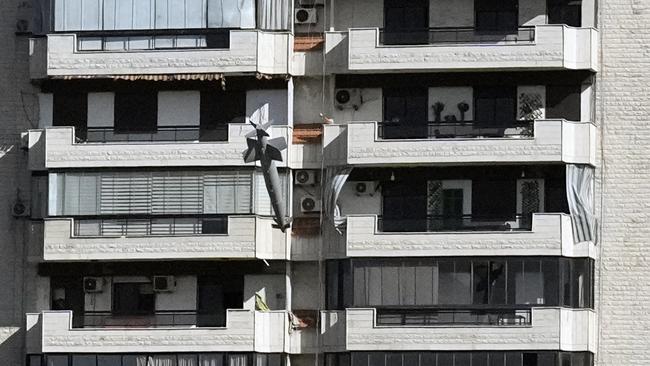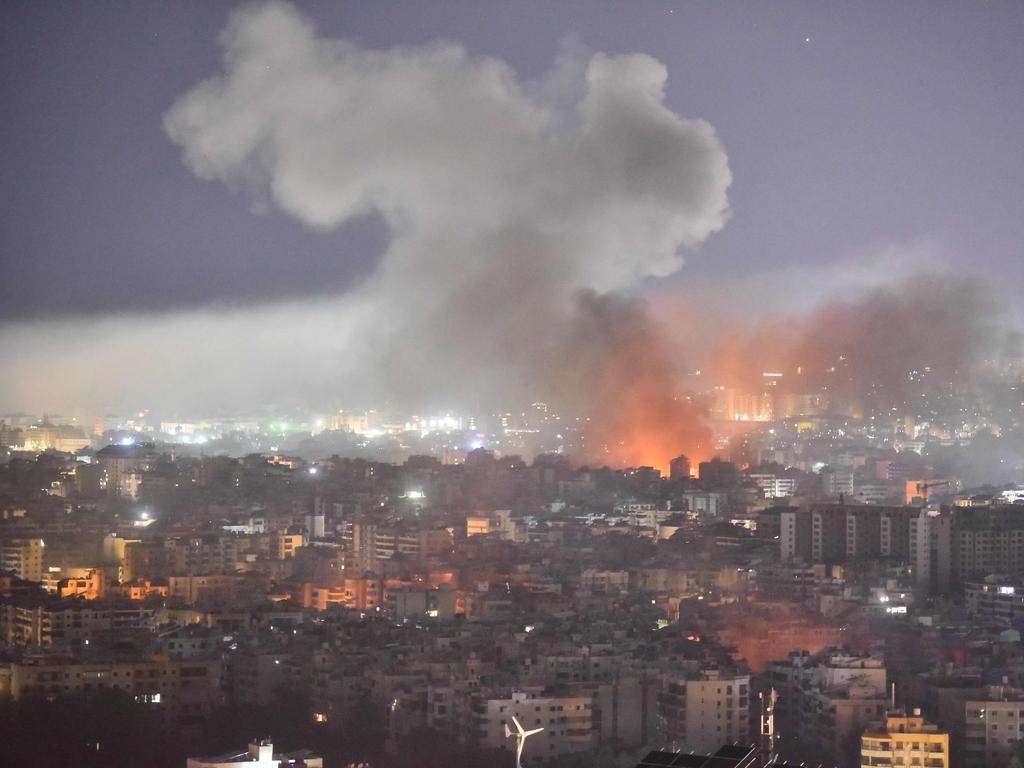Moment 900kg bomb hits Beirut building in Israeli air strike
New images show the descent of the bomb before it slammed into a multistorey block in Beirut, in a strike targeting Hezbollah ‘facilities’.

A month after Israel escalated its war against Hezbollah in Lebanon, air strikes continued to hit Beirut on Tuesday including one 900kg bomb which was caught on camera destroying an apartment building.
A burst of images showed the descent of the bomb before it slammed into the multistorey block in the city’s Ghobeiry neighbourhood, quickly reducing it to rubble.
There was no immediate confirmation of casualties from the destroyed building, which the Israelis said housed “Hezbollah facilities”.
It also came less than a day after another deadly air strike targeted a block in the same area, which is close to the country’s largest public hospital.
With the bomb crater still smoking from the air strike the night before, on Tuesday the rescue workers had to shout over the noise of excavators and men with sledgehammers trying to clear chunks of concrete and debris.

Lebanese Civil Defence Rescue workers suddenly found a hole in the cleared wreckage and shoved their heads in, like foxes at a warren. They told everyone to be quiet. A young man phoned his missing friend. He cried after hearing a phone ringing beneath the rubble.
Across the crater Juma, a local resident, hollered to his friend Ali to check again on their neighbours as the search for survivors continued.
“So many people live here,” he told The Times. “Lebanese, Syrians, Sudanese. The Sudanese man’s home came down on top of him.”
At least 18 people were killed — including four children — and dozens more injured in Monday night’s blast according to an updated death toll on Tuesday released by the Lebanese Ministry of Health.
Of the wounded, seven were in a critical condition receiving treatment at the nearby Rafik Hariri University Hospital, which had its glass entrance hall shattered by the blast. In the vicinity, four buildings were flattened by the strikes.
Israel’s military denied targeting the hospital, but also repeated its argument that Hezbollah was hiding fighters, weapons and money in densely packed residential areas.
“The IDF will continue to operate in accordance with international law against the Hezbollah terrorist organisation, which systematically embeds its terrorist assets into the civilian population,” the Israeli Defence Forces (IDF) said.

The strike, which the IDF said struck a “Hezbollah target”, took place at about 10.30pm local time on Monday — only 20 minutes after the Israeli military’s Arabic spokesperson, Avichay Adraee, warned local residents to leave with evacuation orders posted on X and Telegram.
The area around the hospital, close to the main road to Beirut’s airport, was not mentioned in the evacuation order, Maan Khalil, the mayor of Ghobeiry, said. “Most of the people, they were children and they were sleeping at around 10.30pm,” he said before adding: “And that’s what led now to a lot of missing children under their houses.”
Some of the residents had already fled from southern Lebanon, in an effort to escape Israel’s military campaign. Around the site of the attack, they were on the move again: two men left after returning to a damaged apartment, carrying suits folded over their arms, while migrant workers from Sudan wheeled suitcases containing their belongings through the dust and away from the devastation.
“We have been receiving people from south or from the suburbs to this area. So that’s why we say that it is an overpopulated area,” Khalil said. “It was considered a calm area near a hospital, in a populated and civilian area. So people might find it their last resort to come to it,” he added.
At another medical centre, just under a kilometre away from the Ghobeiry blast, the IDF alleged that Hezbollah was hoarding millions of dollars worth of gold and cash in a former bunker used by the group’s leader Hassan Nasrallah, who was killed by an Israeli air strike late last month.
“Where is the bunker located? Directly under al-Sahel Hospital in the heart of Beirut,” Rear Admiral Daniel Hagari, the Israeli military spokesman, told a press conference on Monday. The IDF released a video animation detailing an underground complex with several rooms and sleeping quarters, accessed by a lift.
On Tuesday morning the hospital staff rejected the claims, and offered the world’s media free access to the building to investigate however they wished.
Standing alone in an operation room in the basement, Halimah El Annan, 56, head of nursing and auditing, said the Israeli claims were absurd. On the floor below there were only morgues, generators and oxygen tanks, she said.
“There is nothing here. No Hassan Nasrallah,” she laughed. “If Hezbollah was hiding stuff, they would give money to the hospital to store it but my basic salary is $400 [a month]. There is not even enough money for medicine.
“I’m scared. I will die if they hit the hospital,” continued the nurse who had worked at the hospital for 40 years. “It’s my second home. My family.”
Mazen Alame, the hospital’s director, said the hospital was independently run and not “not even affiliated to any party,” in Lebanon’s notoriously sectarian politics. “We’re a private hospital. There are not bunkers or tunnels here,” he continued. “It’s impossible and it’s 100 per cent not true.”
Patients were evacuated following the Israeli claims, Alame said. “We don’t trust the Israeli army,” he said. “We evacuated the patients last night with ambulances of the Red Cross.”
Tuesday’s visit was also likely being monitored from afar. As The Times was touring the site, Adraee, the Israeli military Arabic spokesman, tweeted out a message to the foreign press with detailed instructions.
“Go down to Hezbollah’s private shelter. Dargham Street, Building no. 7, Airport Road, Haret Hreik. Entrance and exit in al-Ahmadi Building and Sahel Centre Building. Go there.”
The Times was the first to enter the underground parking lot under the Sahel centre. Two levels underground the only thing visible in the torchlight were abandoned cars, water tanks and boxes of wide format printers from China.
On further inspection of the perimeter three doors were locked with padlocks. Members of the state security services entered the basement in the half light and inspected the doors. One man said that they were the cold storage rooms belonging to the kitchens and restaurants of the centre above ground.
There seemed to be no sign of a Hezbollah bunker, but the IDF spokesman added in a message on X: “It is important to note that it is possible the entrance is hidden by various means in order to make it difficult to find.”
Israel’s attacks on Hezbollah increased from September 23, targeting the group’s leaders and weapons stores. More than 1550 people have been killed in Lebanon since then, according to the country’s health ministry, which does not distinguish between combatants and civilians.
But the renewed offensive has not stopped the militants’ rocket attacks which also continued on Tuesday with volleys launched into northern Israel, wounding at least five people.
Hezbollah also claimed sole responsibility for a drone attack on the Israeli prime minister Benjamin Netanyahu’s home in Caesarea on Saturday. A new picture of the damage caused by the impact showed cracked glass in a bedroom window. There were no injuries, and Netanyahu and his wife were not home at the time.
Lebanon will need $US250 million a month to help more than a million people displaced by Israeli attacks, its minister in charge of responding to the crisis said on Tuesday, ahead of a conference on Thursday in Paris to rally support for Lebanon.
In Beirut, at the hole in the ground left by the Israeli air strike, Ali, crouched down against a wall and stared at the plot where his home used to be. Originally from Idlib in Syria, the 40-year-old fled to Lebanon to escape the civil war in his homeland, only to now find himself in another conflict.
“My family are safe but my home is gone. My friends are still under the rubble,” he said, his hands twisting dust into each other as he echoed a common refrain of Lebanon’s population. “What can I do? Where can I go? Nowhere is safe.”
The Times






To join the conversation, please log in. Don't have an account? Register
Join the conversation, you are commenting as Logout